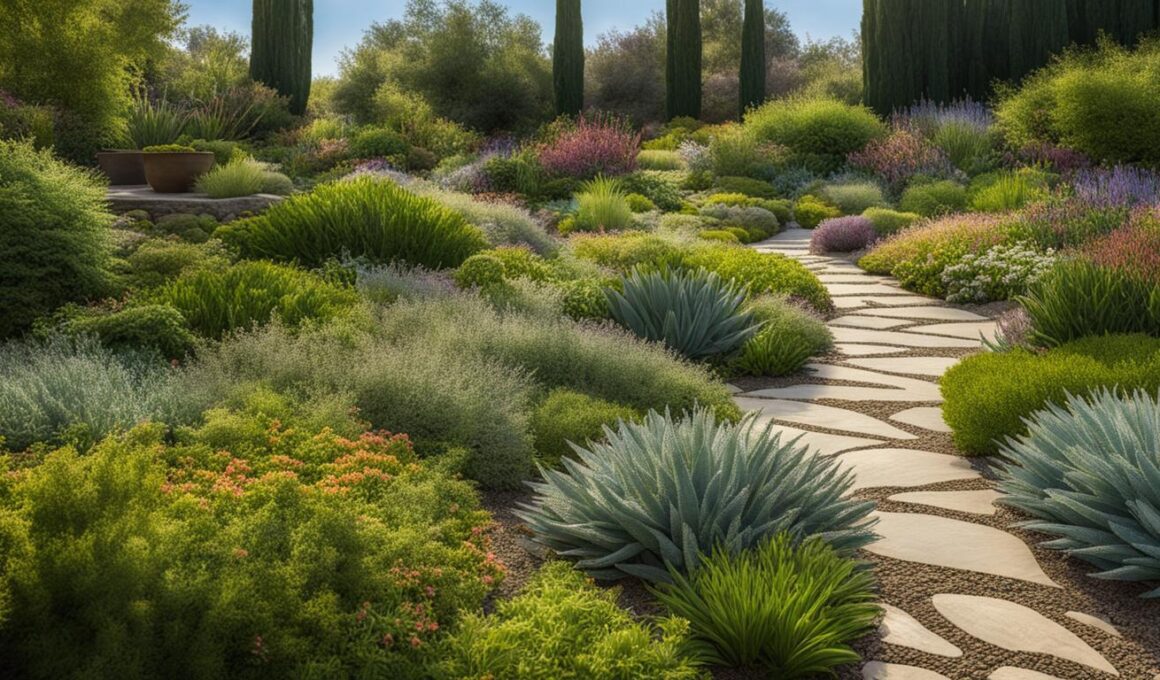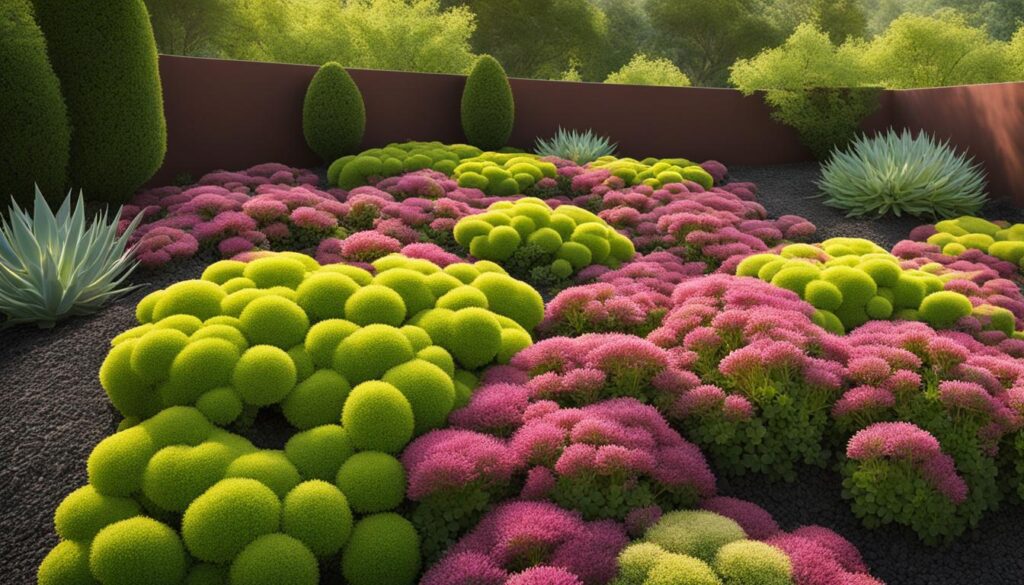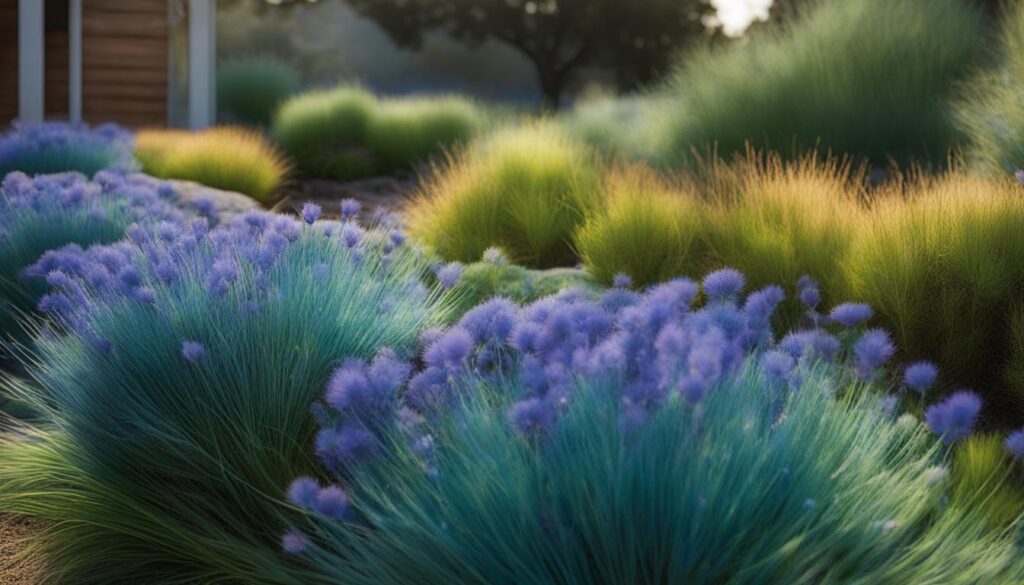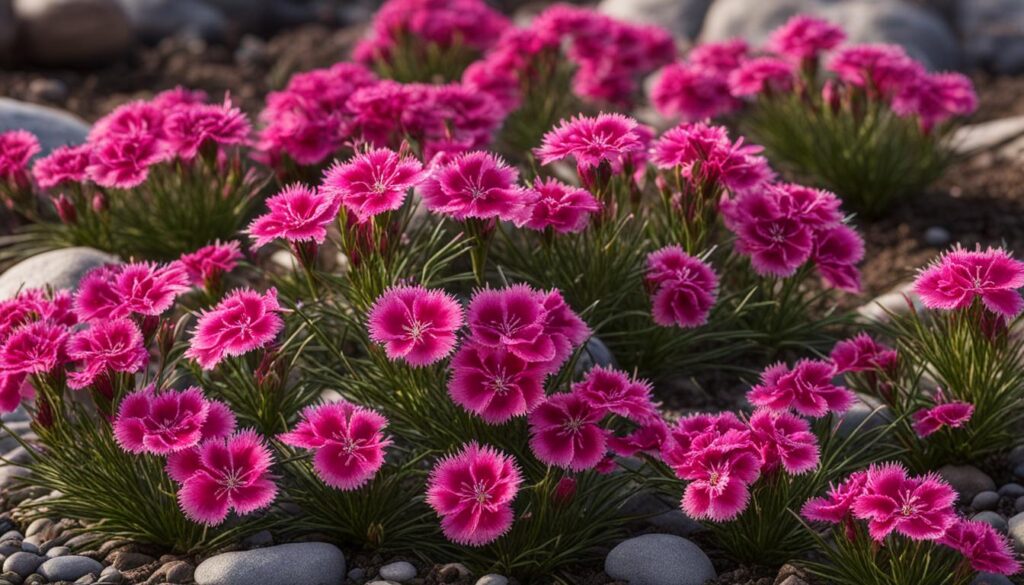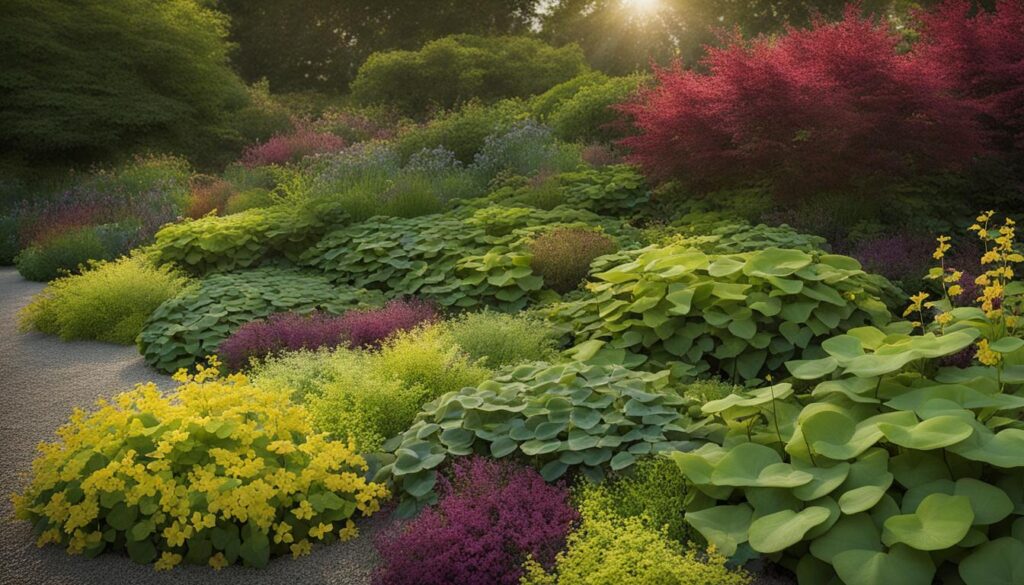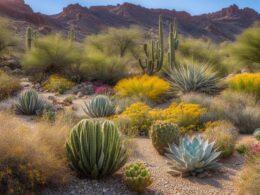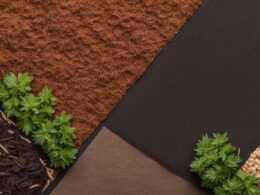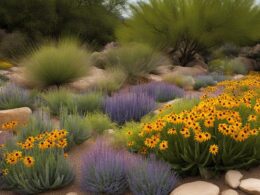Choosing plants that don’t need much water can help create a low-maintenance landscape. These tough, low-growing perennials thrive in hot, sunny locations and can survive without regular watering. They are ideal for arid climates and can add beauty to any garden without the need for excessive maintenance or watering. From ‘Angelina’ sedum to creeping mahonia, there are a variety of drought-tolerant ground cover varieties to choose from that will enhance your garden.
Key Takeaways:
- Choosing drought-tolerant ground cover varieties is a great way to create a low-maintenance garden.
- These plants thrive in hot, sunny locations without the need for regular watering.
- There are a variety of drought-tolerant ground cover varieties to choose from for your garden.
- By incorporating these plants into your landscaping, you can conserve water and achieve a vibrant garden.
- Low-maintenance gardening with drought-tolerant ground cover is a water-wise landscaping choice.
‘Angelina’ Sedum (Sedum rupestre)
If you’re looking for a drought-tolerant ground cover that requires minimal maintenance, ‘Angelina’ sedum (Sedum rupestre) is an excellent choice. This versatile perennial is known for its stunning chartreuse foliage and bright yellow flowers, making it a standout in any garden. With its ability to thrive in hot, sunny locations and go weeks without water, ‘Angelina’ sedum is a reliable and low-maintenance ground cover option.
Deer and rabbit resistant, ‘Angelina’ sedum is a durable plant that can be used in various landscaping applications. It looks fantastic in rock gardens, hanging baskets, and window boxes, adding a pop of color and texture to your outdoor space. This sedum requires full sun and well-drained average soil, making it an easy choice for those looking for a fuss-free ground cover.
In addition to its low watering requirements and low-maintenance nature, ‘Angelina’ sedum is a great choice for its ability to withstand arid climates. Whether you live in a region with limited rainfall or are looking to conserve water in your garden, this drought-tolerant sedum is an eco-friendly and visually appealing option for your landscaping needs.
Blue Fescue (Festuca glauca)
Blue fescue, also known as Festuca glauca, is a popular choice for a low-growing grass that adds beauty and texture to your garden. This drought-tolerant plant features attractive blue-hued stems that grow in a mound, making it ideal for edging garden borders or walkways. Its compact size and dense foliage create a striking visual impact.
One of the greatest advantages of blue fescue is its low-maintenance nature. It requires minimal watering and can withstand hot summers, making it a perfect choice for those looking to conserve water in their garden. A full sun to part shade location, along with well-drained average soil, is all blue fescue needs to thrive.
“Blue fescue is a versatile grass that adds a touch of color and interest to any landscape. Its blue tones create a soothing and calming effect, making it a popular choice for gardeners looking to create a serene environment.”
Table: Blue Fescue Plant Care
| Plant Name | Blue Fescue |
|---|---|
| Scientific Name | Festuca glauca |
| Plant Type | Low-growing Grass |
| Watering Needs | Drought-tolerant |
| Exposure | Full sun to part shade |
| Soil Type | Well-drained, average soil |
| Hardiness Zones | Zones 4-8 |
With its vibrant blue foliage and ability to thrive in challenging conditions, blue fescue is a must-have for any water-wise garden. Whether used as a border plant or repeated throughout the landscape, its unique appearance and easy care make it an excellent choice for both beginner and experienced gardeners alike.
Creeping Mahonia (Mahonia repens)
Creeping Mahonia, also known by its scientific name Mahonia repens, is a versatile and attractive ground cover that offers numerous benefits for your garden. This shade-tolerant plant is not only visually appealing with its glossy evergreen foliage, but it also serves as an excellent erosion control solution. Whether you have steep slopes or shady areas in your garden that require stabilization, creeping mahonia is an ideal choice.
The plant is well-suited for shaded areas, making it a great option for under trees or along the north side of buildings where sunlight is limited. Its spreading habit allows it to form a dense mat that effectively prevents soil erosion. Additionally, creeping mahonia boasts beautiful, fragrant yellow flowers in spring, followed by clusters of blue-black berries, adding further visual interest to your garden.
Caring for creeping mahonia is relatively low-maintenance. Once established, it can tolerate drier conditions, reducing the need for regular watering. It prefers well-drained, average soil and can thrive in both full sun to part shade. Pruning is generally not necessary, but you can trim the plant back to shape if desired. Overall, creeping mahonia is a versatile and hardy ground cover that adds beauty and functionality to your garden.
Benefits of Creeping Mahonia as an Erosion Control Ground Cover:
- Stabilizes steep slopes and prevents soil erosion
- Thrives in shaded areas with limited sunlight
- Forms a dense mat that effectively covers the ground
- Offers visual interest with fragrant yellow flowers and blue-black berries
- Tolerates drier conditions once established
- Low-maintenance and easy to care for
“Creeping mahonia is an ideal choice for gardeners looking to prevent erosion in shaded areas. Its spreading habit and dense mat formation make it an effective ground cover while adding beauty to the landscape.”
| Plant Name | Creeping Mahonia |
|---|---|
| Scientific Name | Mahonia repens |
| Common Names | Creeping Mahonia, Oregon Grape |
| Plant Type | Evergreen shrub |
| Height | 8-18 inches |
| Spread | 3-6 feet |
| Sun Exposure | Full sun to part shade |
| Soil Type | Well-drained, average soil |
| Hardiness Zones | 3-8 |
Dianthus ‘Firewitch’ (Dianthus gratianopolitanus)
If you’re looking for a drought-resistant flowering plant that adds a pop of color to your garden, look no further than Dianthus ‘Firewitch’ (Dianthus gratianopolitanus). This low-growing perennial is a beautiful addition to any landscape, offering stunning pink flowers with fringed edges. Not only does it provide visual appeal, but it also thrives in hot, dry summers without requiring much maintenance or watering.
Dianthus ‘Firewitch’ forms dense mats of foliage, making it an excellent choice for ground cover or as a border plant. It requires full sun to part shade and well-drained, average soil. With its compact size and vibrant blooms, it adds a touch of elegance to rock gardens, raised beds, or containers. To encourage new foliage growth, it’s advisable to shear off the faded flowers and stems after blooming.
“Dianthus ‘Firewitch’ is a stunning, low-growing perennial that can withstand hot, dry summers. Its vibrant pink flowers and fringed edges create a beautiful display in any garden. With its drought-resistant nature and low-maintenance requirements, it’s a fantastic choice for gardeners looking to conserve water while adding beauty to their landscape.”
When using Dianthus ‘Firewitch’ in your garden, be sure to provide it with adequate space to spread and thrive. It’s important to note that this perennial can be sensitive to excessive moisture or wet conditions. Therefore, it’s crucial to ensure proper drainage and avoid overwatering. By incorporating Dianthus ‘Firewitch’ into your landscape, you can enjoy its stunning blooms while conserving water and creating a low-maintenance garden.
Benefits of Dianthus ‘Firewitch’
- Beautiful pink flowers with fringed edges
- Drought-resistant and thrives in hot, dry summers
- Low-growing and forms dense mats of foliage
- Requires minimal maintenance and watering
- Ideal for rock gardens, raised beds, or containers
Tips for Growing Dianthus ‘Firewitch’
- Plant in full sun to part shade
- Ensure well-drained, average soil
- Shear off faded flowers and stems after blooming
- Provide adequate space for spreading
- Avoid overwatering and excessive moisture
| Plant Type | Height | Spread | Sun Exposure | Soil Type |
|---|---|---|---|---|
| Perennial | 6-8 inches | 12-18 inches | Full Sun to Part Shade | Well-drained, average soil |
Epimedium (Barrenwort)
Epimedium, also known as barrenwort or barrenroot, is a shade-tolerant ground cover that adds beauty and functionality to your garden. This low-maintenance plant offers heart-shaped leaves in various colors and pretty pendulous blooms, creating a visually appealing ground cover for shaded areas.
With its ability to spread slowly and retain foliage in warmer regions, epimedium is a reliable choice for those seeking an attractive and durable ground cover. This plant is deer-resistant and requires part to full shade and well-drained, average soil, making it adaptable to a variety of garden conditions.
In early spring, it is recommended to cut back any foliage to maintain its appearance. This simple maintenance step ensures that epimedium continues to thrive and provide an elegant ground cover solution for your garden.
Benefits of Epimedium as a Ground Cover:
- Shade-tolerant: Epimedium thrives in shaded areas where other ground covers may struggle to grow.
- Low-maintenance: Once established, this plant requires minimal maintenance, making it ideal for busy gardeners.
- Deer-resistant: Epimedium is naturally resistant to deer, keeping your garden protected.
- Attractive foliage and blooms: The heart-shaped leaves and pendulous flowers add a touch of elegance to your garden.
- Durable: Epimedium can withstand different weather conditions and retain its foliage in warmer regions.
“Epimedium is a versatile ground cover that thrives in shaded areas and requires minimal maintenance. Its attractive foliage and blooms make it a popular choice for gardeners looking to enhance their outdoor spaces.” – Gardening Magazine
| Features | Epimedium |
|---|---|
| Watering Needs | Low |
| Sun Requirements | Part to full shade |
| Soil Type | Well-drained, average soil |
| Maintenance | Low |
| Hardiness Zones | Dependent on variety, typically 3-7 |
‘Ice Plant’ – Drought-Tolerant Succulent Ground Cover
In your quest for drought-tolerant ground cover varieties, the ‘Ice Plant’ is an excellent choice. This resilient succulent, scientifically known as Delosperma, is well-suited to low-maintenance landscaping and can thrive in hot and dry conditions. Its unique needle-like foliage and vibrant purple-pink flowers make it a visually striking addition to any garden.
The ‘Ice Plant’ is known for its ability to tolerate poor, dry soil and low water availability, making it a water-wise option for your garden. Its low-growing nature also makes it an ideal ground cover, filling in gaps and creating a dense and vibrant carpet of succulent foliage. Whether you’re looking to cover sunny slopes, rock gardens, or other areas in need of some greenery, the ‘Ice Plant’ is up to the task.
Benefits of the ‘Ice Plant’ as a Ground Cover:
- Drought-tolerant: The ‘Ice Plant’ can withstand hot and dry conditions, making it an ideal choice for arid climates.
- Low-growing: It spreads close to the ground, forming a thick and attractive mat of foliage that helps suppress weeds and erosion.
- Colorful blooms: The purple-pink daisy-like flowers of the ‘Ice Plant’ add a burst of vibrant color to your garden when it blooms in late spring to early summer.
- Low maintenance: With its minimal water requirements and ability to withstand neglect, the ‘Ice Plant’ is perfect for those looking for a fuss-free ground cover.
“The ‘Ice Plant’ is a hardy and beautiful ground cover that can add color and texture to your garden while requiring minimal care and water.” – Gardening Expert
When planting the ‘Ice Plant’, ensure it receives full sun exposure and is planted in well-drained soil. Avoid overwatering as the ‘Ice Plant’ is susceptible to root rot. With proper care, this low-growing ground cover will thrive and provide an attractive and water-wise solution for your garden.
| Plant name | Drought tolerance | Growth habit | Flower color |
|---|---|---|---|
| ‘Ice Plant’ (Delosperma spp.) | Very drought-tolerant | Low-growing succulent | Purple-pink |
| ‘Angelina’ Sedum (Sedum rupestre) | Drought-tolerant | Low-growing perennial | Yellow |
| Blue Fescue (Festuca glauca) | Highly drought-tolerant | Low-growing grass | Blue |
Moss Phlox: The Perfect Low-Growing Flowering Plant for Full Sun Ground Cover
Moss phlox (Phlox subulata) is a stunning low-growing flowering plant that serves as an excellent ground cover option for areas with full sun. Its vibrant colors and ability to form a dense mat make it a popular choice for gardeners looking to add beauty and functionality to their landscapes.
This drought-tolerant plant features dark green, needle-like foliage that provides an attractive backdrop for its star-shaped flowers. Moss phlox blooms in a variety of colors, including blue, violet, pink, and white, creating a colorful display in early spring. Its low-spreading growth habit makes it ideal for covering larger areas or replacing traditional lawns.
To ensure optimal growth, moss phlox thrives in full sun, requiring at least six hours of direct sunlight per day. It also prefers well-drained soil, making it a suitable option for various garden styles. Whether used in rock gardens, bordering pathways, or cascading down slopes, moss phlox adds a touch of beauty and elegance to any landscape.
Benefits of Moss Phlox as a Ground Cover
Choosing moss phlox as a ground cover plant offers several benefits for both the gardener and the landscape. Here are some advantages of incorporating moss phlox into your garden:
- Low maintenance: Once established, moss phlox requires minimal maintenance, making it a hassle-free option for busy gardeners.
- Attracts pollinators: The vibrant flowers of moss phlox attract bees and butterflies, contributing to a pollinator-friendly garden.
- Erosion control: The dense mat formed by moss phlox helps prevent soil erosion, making it an excellent option for sloping areas.
- Drought tolerance: Moss phlox is highly drought-tolerant, meaning it can survive in hot, dry conditions with minimal water requirements.
With its breathtaking flowers, low-maintenance nature, and ability to thrive in full sun, moss phlox is an excellent choice for gardeners seeking a visually appealing and water-wise ground cover solution. Its resilience and adaptability make it a valuable addition to any garden, providing year-round beauty and functionality.
Ostrich Fern (Matteuccia struthiopteris)
The Ostrich Fern, scientifically known as Matteuccia struthiopteris, is a versatile and drought-tolerant fern that serves as an excellent choice for woodland ground cover. With its feathery fronds and ability to adapt to various light conditions, this fern adds a touch of elegance and lushness to shady areas of your garden. Despite its preference for moist soil, the Ostrich Fern has proved surprisingly resilient in drought conditions, making it a valuable addition to water-wise landscaping.
“The Ostrich Fern is a true survivor, capable of thriving in the face of limited water availability. Its lush green foliage and graceful growth make it a stunning option for adding visual interest to woodland gardens and shaded hillsides.”
This fern is known for its unique reproductive cycle, as it produces fertile fronds that resemble the plumes of an ostrich, hence its name. These fertile fronds stand tall and erect, while the non-fertile fronds arch gracefully, creating a lush and textural effect. The Ostrich Fern is adaptable to both full sun and full shade, making it a versatile choice for different garden areas.
When planting the Ostrich Fern, it’s important to provide well-drained soil and regular watering until established. Once established, this fern can tolerate drier conditions, but adequate moisture is still necessary for optimal growth. In periods of drought, the Ostrich Fern may not grow as tall or spread as quickly, but it will continue to thrive and provide a beautiful, low-maintenance ground cover option for your woodland garden.
The Benefits of Ostrich Fern as a Drought-Tolerant Fern:
- Adaptable to a wide range of light conditions, from full sun to full shade.
- Resilient and capable of surviving in periods of drought.
- Provides lush and textural foliage, adding visual interest to woodland gardens.
- Thrives in well-drained soil and requires moderate moisture.
- Low-maintenance and easy to grow, making it an ideal choice for water-wise landscaping.
Table: Comparison of Ostrich Fern with Other Drought-Tolerant Ferns
| Fern Variety | Light Requirements | Drought Tolerance | Growth Habit |
|---|---|---|---|
| Ostrich Fern (Matteuccia struthiopteris) | Full sun to full shade | Resilient in periods of drought | Arching fronds with ostrich-like fertile fronds |
| Lady Fern (Athyrium filix-femina) | Partial to full shade | Tolerates dry spells but prefers moist soil | Upright fronds with delicate and lacy appearance |
| Cinnamon Fern (Osmunda cinnamomea) | Partial to full shade | Requires consistent moisture | Tall and erect fronds with cinnamon-colored fertile spikes |
Periwinkle (Vinca minor)
Periwinkle, also known as creeping myrtle, is a versatile and hardy ground cover that can transform your garden into a lush, green oasis. With its dense growth habit and beautiful glossy leaves, periwinkle is an excellent choice for adding depth and texture to your landscape. This shade-tolerant plant thrives in areas where other plants may struggle, making it ideal for shady spots under trees or along fences.
One of the most appealing qualities of periwinkle is its ability to form a dense, evergreen mat that effectively suppresses weeds. This makes it a low-maintenance option for areas where you want to reduce the need for regular weeding. Once established, periwinkle requires minimal care, making it an excellent choice for busy gardeners or those who want to spend less time on maintenance tasks.
Periwinkle is well-suited to a variety of soil types and can adapt to different growing conditions. Whether you have sandy soil, clay soil, or something in between, periwinkle can thrive and provide excellent ground cover. Its ability to tolerate dry shade also makes it a valuable addition to gardens with limited sunlight.
| Attributes | Details |
|---|---|
| Growth Habit | Creeping, mat-forming |
| Leaf Color | Glossy green or variegated |
| Flower Color | Blue, purple, or white |
| Sun Requirements | Full sun to part shade |
| Soil Type | Well-drained |
| Hardiness Zones | 4-9 |
When planting periwinkle, it’s important to consider local regulations and restrictions, as it can become invasive in some regions. Before adding periwinkle to your garden, check with your local agricultural extension office or plant nursery to ensure it is a suitable choice for your area. With its attractive foliage, easy care requirements, and ability to thrive in shade, periwinkle is a fantastic option for creating a dense ground cover that will enhance the beauty of your garden.
Conclusion
Choosing drought-tolerant ground cover varieties is a smart choice for your garden. These plants not only add beauty but also help you maintain a low-maintenance garden while conserving water. With their ability to thrive in arid climates and withstand hot, sunny locations, these ground covers eliminate the need for regular watering, making them perfect for water-wise landscaping.
From the striking ‘Angelina’ sedum to the versatile creeping mahonia, there is a wide range of drought-tolerant ground cover varieties to choose from. Their resilience and ability to survive without excessive watering make them ideal for low-maintenance gardening. Incorporating these ground covers into your landscaping not only reduces the need for excessive watering but also adds a touch of green and vibrancy to your garden.
By opting for drought-tolerant ground covers, you can create a beautiful garden that requires minimal effort to maintain. Embracing these low-maintenance plants not only enhances the aesthetics of your garden but also promotes water conservation. So, consider adding drought-tolerant ground cover varieties to your garden and enjoy the benefits of a stunning, water-wise landscape.
FAQ
Can drought-tolerant ground cover varieties survive without regular watering?
Yes, these tough, low-growing perennials can thrive in hot, sunny locations and can survive without regular watering.
Which ground cover is best for hot, sunny locations?
‘Angelina’ sedum is an extra-easy perennial that thrives in hot, sunny locations and can go weeks without water.
What ground cover is ideal for edging garden borders?
Blue fescue is a low-growing grass that is perfect for edging garden borders or walkways.
Which ground cover is suitable for shaded areas?
Creeping mahonia is an ideal ground cover for shaded areas and can tolerate drier conditions after the first year of watering.
Can Dianthus ‘Firewitch’ tolerate hot, dry summers?
Yes, Dianthus ‘Firewitch’ thrives in normal to sandy soils and can easily tolerate hot, dry summers.
What ground cover is shade-tolerant?
Epimedium, also known as barrenwort, is a shade-tolerant ground cover that offers beautiful heart-shaped leaves and pendulous blooms.
Can ice plant grow well in hot and dry locations?
Yes, ice plant thrives in hot and dry locations such as sunny slopes and rock gardens.
What ground cover is suitable for covering larger areas or replacing a traditional lawn?
Moss phlox is a low-growing plant that forms a dense mat and is ideal for covering larger areas or replacing a traditional lawn.
Is ostrich fern drought-tolerant?
Yes, ostrich fern is surprisingly drought-tolerant, although it may not grow as tall or spread as quickly during periods of drought.
Can periwinkle be planted in dry shade?
Yes, periwinkle, also known as creeping myrtle, can be planted in dry shade and forms a dense, evergreen mat.
How can choosing drought-tolerant ground cover varieties benefit my garden?
Choosing drought-tolerant ground cover varieties can create a low-maintenance garden while conserving water and reducing the need for excessive watering.





